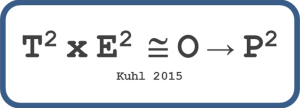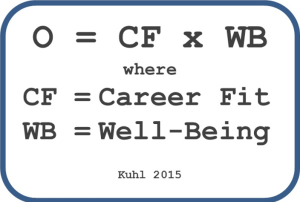At one point in my life, I felt called to be an elementary school teacher. One of the many useful things I learned while getting my  M.Ed. was the concept of the spiral teaching method, where you start with a high-level overview, and then delve progressively more deeply into complex topics. (Later, during my brief fling in the public school system, I learned something else useful. Specifically that I am wildly unsuited to be an elementary school teacher. But that’s a tale for another day.)
M.Ed. was the concept of the spiral teaching method, where you start with a high-level overview, and then delve progressively more deeply into complex topics. (Later, during my brief fling in the public school system, I learned something else useful. Specifically that I am wildly unsuited to be an elementary school teacher. But that’s a tale for another day.)
Anyway…now that you are familiar with the elements of both the original Performance Equation and my equation representing the Theory of Well-Being , this is an opportune time to loop back to the concepts of Opportunity and congruence, and expand our understanding.
 Sitting there in the Exponential Performance equation, poor old O-for-Opportunity seems pretty plain. Not even an exponent to call its own. But as you will soon see, this humble ring actually encircles quite a critical chunk of territory!
Sitting there in the Exponential Performance equation, poor old O-for-Opportunity seems pretty plain. Not even an exponent to call its own. But as you will soon see, this humble ring actually encircles quite a critical chunk of territory!
In his book, Principles of Self-Management (1999), Dr. John Marshall defines Opportunity simply as being one’s work environment. And in explaining his Performance Equation, he notes that your  Talent and Effort are best used, and consistent success is explained by, “being the right person in the right place at the right time.” In this view, then, Opportunity comprises the job and the organizational culture in which you are expected to execute that job. And your career is an isolated subset of your life.
Talent and Effort are best used, and consistent success is explained by, “being the right person in the right place at the right time.” In this view, then, Opportunity comprises the job and the organizational culture in which you are expected to execute that job. And your career is an isolated subset of your life.
Because my quest is to develop a unified theory for helping humans be self-energizing and more fulfilled in work and in life, my view of Opportunity is not bounded by job descriptions, cubical walls, the gang at the office, and the 40-hour workweek (okay, make that 60 hours…80, tops).
In one episode of A Prairie Home Companion, Garrison Keillor’s character, a writer, is asked if he writes fiction or non-fiction, to which he replies, “I don’t make that sharp distinction.”
Today, if you ask many of us if we are engaged in “work” or “life” at any given moment, we’d probably have to say, “I don’t make that sharp distinction.” Just to give one example, today I’m in my home  office, doing laundry as a background task, and striving to concentrate on my top priority project (i.e., writing this blog) while being periodically pestered by work-related calls from my business partner, panting and wagging visits from our new puppy, emails from clients, and loud requests from the cat for a two-handed, full-body scratch.
office, doing laundry as a background task, and striving to concentrate on my top priority project (i.e., writing this blog) while being periodically pestered by work-related calls from my business partner, panting and wagging visits from our new puppy, emails from clients, and loud requests from the cat for a two-handed, full-body scratch.
Am I living or working? Yes!
Even if your work setting is far less permeable than mine, you know that worries about personal issues leach into your thoughts when you are officially “at work.” And the Grump Mode setting from a rough day at the office doesn’t always flip immediately to Cheerful Mode just because you’ve finally escaped to your home and family. Especially when the *%$#@! boss texts you during dinner.
In an earlier post, I asserted that you can achieve exponential levels of Performance when you work in a congruent Opportunity—one that aligns with your interests, respects your Attitudes, and rewards you for consistently putting your Talents (both Inherent and Trainable) into Action to the benefit of both you and the organization.
 This is the first level of exponential performance, focused on performance solely in the context of your work life. This component of Opportunity is Career Fit, notated in the latest equation as CF.
This is the first level of exponential performance, focused on performance solely in the context of your work life. This component of Opportunity is Career Fit, notated in the latest equation as CF.
Attaining the second level of exponential performance requires you to expand your understanding of Opportunity—and your search for Congruence—by integrating into them the five elements that make up Well-Being (WB): Positive Emotion, Engagement, Relationships, Meaning, and Accomplishment. This level acknowledges that life and career are inextricably intertwined. Achieving true high performance in one at the cost of completely sacrificing the other isn’t really even possible (not as long as you are pursuing a career, anyway).
Finding a congruent opportunity is still the key to taking your performance to exponential levels while enjoying an overall sense of well-being. Congruent Opportunities:
- Provide a culture aligned with your values
- Serve a purpose you believe in and care about
- Require someone with your inherent traits, as well as your specific skills, knowledge, and abilities
- Minimize friction (i.e., anything that makes it difficult for you to exercise your Talents to the fullest extent of your Effort)
With this broader understanding in view, here’s my comprehensive definition of the kind of Opportunity that engenders total exponential performance: an environment in which I am rewarded for, and experience Engagement by, investing maximum Effort in using my strongest Talents to achieve Accomplishments that are Meaningful to me while maintaining Relationships that are mutually beneficial and fulfilling, and enjoying the Positive Emotions that result from these activities, interactions, and achievements. Note that all of this applies inside and outside of career context.
You achieve true Performance2 only when all of these elements are in optimal balance…as you perceive it.
Yes, perception is key, as we’ll explore in the next post. Rather like the character played by John Astin in the Night Gallery episode “Hell’s Bells,” one person’s congruent opportunity could be another person’s worst nightmare!
~~~